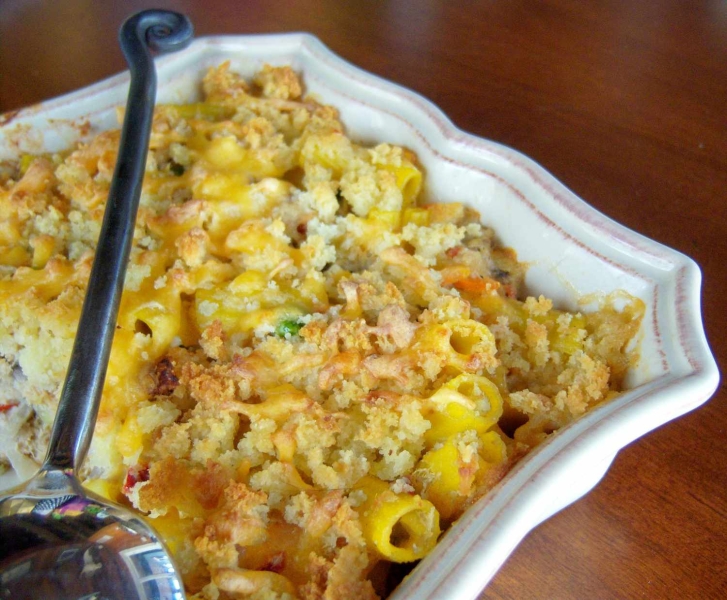Prep: 15 mins
Cook: 35 mins
Total: 50 mins
Servings: 6 to 8 servings
This tuna casserole recipe is creamy, delicious, and gluten free—finally, classic comfort food for those on gluten-restrictive diets.
Use your favorite gluten-free pasta shape: Rigatoni, macaroni, or shells produce very good results.
Also, for convenience or to save the time involved in making your own gluten-free cream of mushroom soup, use canned cream of mushroom soup that is not condensed and does not require dilution.
Serve with a fresh green salad or green vegetable.
Ingredients
-
Kosher salt, to taste
-
8 ounces gluten-free pasta
-
1 cup frozen sweet peas
-
3 tablespoons unsalted butter
-
1/2 cup finely diced sweet yellow onion
-
1/2 cup finely diced red bell pepper
-
4 tablespoons sweet rice flour
-
1 3/4 cups milk, or half-and-half
-
1 1/2 cups canned or homemade gluten-free cream of mushroom soup
-
1/4 teaspoon freshly ground black pepper, or to taste
-
1 (12-ounce) can tuna packed in water
-
2 cups shredded cheese, divided
-
1 cup gluten-free breadcrumbs
-
1 teaspoon olive oil
Steps to Make It
-
Heat oven to 350 F/176 C. Cook pasta in salted water, according to package directions.
-
Add frozen peas 2 minutes before pasta is done.
-
Drain pasta and peas and rinse in cold water. Put into a large mixing bowl.
-
Melt butter in a medium saucepan. Add the onion and red pepper and sauté over medium-low heat until crisp-tender, stirring occasionally, about 3 minutes.
-
Sprinkle sweet rice flour over vegetables and stir well. Continue cooking, stirring, for another 3 minutes.
-
Whisk in the milk, soup, and salt and pepper to taste. Stir on low heat until the mixture begins to simmer and thicken.
-
Carefully pour cooked sauce over the cooked macaroni and peas that have been reserved in the large bowl.
-
Drain the tuna, break into small pieces, and add to the bowl with 1 1/2 cups of the cheese and stir to combine.
-
Pour the mixture into a 13 x 9-inch (3-quart) buttered casserole dish and top with the remaining 1/2 cup of cheese.
-
Mix breadcrumbs with olive oil until combined and sprinkle evenly over the casserole.
-
Bake for 35 to 40 minutes, until bubbling and browned, and serve.
Reminder
Always make sure your work surfaces, utensils, pans, and tools are free of gluten. Always read product labels. Manufacturers can change product formulations without notice. When in doubt, do not buy or use a product before contacting the manufacturer for verification that the product is free of gluten.
Recipe Variations
- Casseroles such as these lend themselves to substitution and experimentation by varying the protein, vegetables, and soup used. You easily can substitute 12 ounces of cooked and cubed rotisserie chicken or grilled chicken for the tuna and gluten-free cream of chicken soup for the mushroom soup.
- Have a lot of leftover ham? Use it in this casserole with fresh mushrooms, Swiss cheese, and the soup of your choice.
- Shrimp and crab are two other possibilities for this dish. Since seafood easily can be overcooked, you might want to start with blanched but not fully cooked shrimp or crab. Since the blanched seafood will give off more liquid than fully-cooked proteins, the sauce might be a little soupy but will thicken on standing. Gluten-free shrimp soup would be perfect here. Cheese is not a natural accompaniment for seafood, so you might want to eliminate it and use a thicker layer of crumbs on top.
- If you have a gluten-free vegan in the house, use textured vegetable protein or tofu, vegan cheese and dairy-free milk, mixed frozen vegetables, and add more fresh vegetables like meaty portobello mushrooms (remove the gills so they don’t turn the sauce dark).
| Nutrition Facts | |
|---|---|
| Servings: 6 to 8 | |
| Amount per serving | |
| Calories | 363 |
| % Daily Value* | |
| Total Fat 19g | 24% |
| Saturated Fat 10g | 49% |
| Cholesterol 63mg | 21% |
| Sodium 2344mg | 102% |
| Total Carbohydrate 26g | 9% |
| Dietary Fiber 3g | 12% |
| Total Sugars 7g | |
| Protein 22g | |
| Vitamin C 18mg | 91% |
| Calcium 318mg | 24% |
| Iron 1mg | 6% |
| Potassium 358mg | 8% |
| *The % Daily Value (DV) tells you how much a nutrient in a food serving contributes to a daily diet. 2,000 calories a day is used for general nutrition advice. | |


